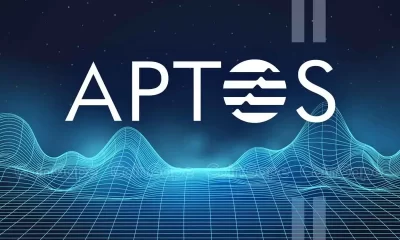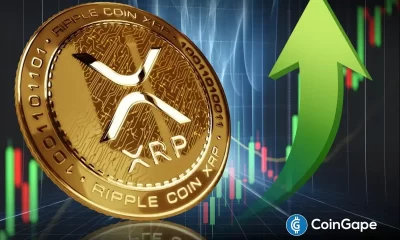Bitcoin For Corporations
Strategy CEO Makes The Case For Corporate Bitcoin Adoption In MIT Keynote
Published
1 week agoon
By
admin
At a recent keynote delivered at the MIT Bitcoin Expo, Phong Le, CEO of Strategy (NASDAQ: MSTR), made a bold case for Bitcoin as a core component of modern corporate treasury strategy. With over 528,000 BTC on its balance sheet, Strategy has become the most visible—and arguably the most successful—public company to adopt Bitcoin as a primary reserve asset.
“We outperformed the entire Nasdaq, the entire S&P 500, the entire Mag Seven… and we outperformed Bitcoin,” Le told the audience.
While Strategy Chairman Michael Saylor laid the philosophical foundation for Bitcoin’s corporate use case starting in 2020, Le’s keynote drove home the executional and financial results. The talk, which was part challenge and part case study, urged corporate leaders to question everything from their education to their financial assumptions—and to reimagine their balance sheet in the Bitcoin era.
Corporations Aren’t Performing—And Bitcoin Offers a Way Out
On Day 1 of the MIT Bitcoin Expo, Le opened with a breakdown of corporate America’s performance problem. Of the 35 million companies in the U.S., only the top tier—primarily S&P 500 firms—are meeting market expectations. The rest are stagnating. “Almost every other company is not performing,” Le said.
He pointed the finger at entrenched financial orthodoxy. MBA programs, elite consultancies, and Wall Street firms continue to teach the same playbook: optimize the income statement, reinvest in traditional assets, and stick to quarterly thinking. The result is systemic underperformance. “All they can do is the S&P 500,” he said, noting even private equity, venture capital, and hedge funds rarely beat that benchmark.
Le’s thesis: it’s not a lack of talent—it’s a lack of imagination.
Strategy’s Bitcoin Playbook: From Cash Drag to Digital Capital
What set Strategy apart, Le argued, was its decision to treat the balance sheet as a strategic asset—rather than a passive one. While most companies park cash in low-yield government bonds or commodities like gold, Strategy chose Bitcoin.
“Why, if you’re a company, wouldn’t you do the same thing? Make money off of your balance sheet. Makes sense.”
Le made the point that Bitcoin offers not just return potential, but structural advantages: it trades 24/7, it isn’t subject to central bank policy, and it provides corporations with instant global liquidity. By contrast, traditional capital markets operate “252 days a year, 6.5 hours a day—19% of the time.”
Strategy has embraced this fully, updating its Bitcoin reserves in real time. “We show our results daily. In fact, we update them every fifteen seconds on our website,” Le said.
Rethinking Accounting in a Bitcoin-Native World
One of the biggest challenges for corporations adopting Bitcoin is the mismatch between traditional accounting rules and a 24/7 asset. Current standards were built for quarterly earnings and slow-moving financial instruments—not real-time, globally traded digital assets.
As Phong Le put it: “Accounting policies update every five years, quinquennially. Accounting policies don’t work for Bitcoin.”
Under GAAP, Bitcoin is treated as an intangible asset—marked down when prices fall, but not adjusted upward when they rise—creating a distorted view of financial health.
To close that gap, Strategy has adopted a more transparent approach. “We show our results daily. In fact, we update them every fifteen seconds on our website,” Le said. This real-time reporting reflects the always-on nature of Bitcoin and signals to the market that Strategy is playing by a different—and faster—set of rules.
Rather than wait for institutions to catch up, Strategy is setting the standard for how the performance of Bitcoin treasury companies should be measured.
Why MSTR Stock Became the Most Watched in the U.S. Market
Since adopting its Bitcoin treasury strategy, MSTR stock has become “the most performant, the most volatile, the highest volume, and most interesting stock in the United States,” according to Le. Its performance has consistently outpaced traditional benchmarks—not just because Bitcoin appreciated, but because Strategy leaned into its identity as a Bitcoin-native public company.
And it’s not alone. Le highlighted the growing list of companies replicating the model: Metaplanet, Semler Scientific, and KULR Technology Group, all of which outperformed the S&P 500 and Bitcoin after adopting similar treasury strategies. “This is a replicable strategy,” Le said. “Everyone else should be doing this.”
Breaking the Mold: A Corporate Call to Courage
Le closed by challenging executives and investors to question conventional wisdom. Strategy’s success didn’t come from following the crowd—it came from rejecting it.
“It takes courage. It takes original thinking. It takes independent thinking. It takes bravery. It takes Bitcoin.”
As the first public company to turn Bitcoin into a cornerstone of its balance sheet, Strategy—under Michael Saylor’s vision and Phong Le’s leadership—has redefined what’s possible in corporate finance.
Or, as Le put it: “Bitcoin allows corporations to find freedom from the average.”
Disclaimer: This content was written on behalf of Bitcoin For Corporations. This article is intended solely for informational purposes and should not be interpreted as an invitation or solicitation to acquire, purchase, or subscribe for securities.
Source link
You may like


Bitcoin Price Holds Steady, But Futures Sentiment Signals Caution


Panama City Approves Bitcoin And Crypto Payments For Taxes, Fees, And Permits


Crypto Trader Says Solana Competitor Starting To Show Bullish Momentum, Updates Outlook on Bitcoin and Ethereum


weakness signals move toward lower support


Now On Sale For $70,000: The World’s First Factory Ready Open-Source Humanoid Robot


What Next for ETH as Traders Swap $86M into Solana DeFi protocols ?
Bitcoin For Corporations
The Smarter Web Company’s UK IPO To Include Retail Access And Bitcoin Treasury Plan
Published
2 days agoon
April 15, 2025By
admin
Retail Access Confirmed for The Smarter Web Company’s IPO
The Smarter Web Company is offering retail investors in the UK a rare opportunity to participate in its upcoming IPO—providing access to a digital services firm that is also integrating a Bitcoin treasury strategy as part of its long-term financial plan.
Set to list on the Aquis Stock Exchange Growth Market on April 25, 2025, the company is raising up to £2 million through a combination of institutional and retail subscriptions. The retail offer is available via the Winterflood Retail Access Platform (WRAP) and will remain open until 5:00 p.m. on April 17, 2025. Applications can be made using funds held within ISAs and SIPPs, with a minimum subscription of £500.
Retail allocations at the IPO stage remain uncommon in UK markets, making this a noteworthy opportunity for individual investors to take part in the early phase of a public company that blends traditional growth strategy and forward-thinking capital management with a Bitcoin treasury strategy in place.
Importantly, this IPO is being carried out through Uranium Energy Exploration PLC, an existing unlisted PLC that, upon Admission, will acquire The Smarter Web Company Limited and be renamed The Smarter Web Company PLC. The listing serves as the formal vehicle for that transition—turning the shell into a fully operating digital services company with a Bitcoin treasury strategy.
A Digital Services Business With Strategic Reserve Alignment
Founded in 2009, The Smarter Web Company delivers web design and digital marketing services to businesses of all sizes. With a scalable product offering and proven revenue model, it’s well-positioned to grow through both organic expansion and targeted acquisitions.
Now, as it prepares to go public, the company is implementing a Bitcoin Treasury Strategy that includes allocating a portion of reserves to Bitcoin. This isn’t a pivot or transformation—it’s a forward-thinking enhancement to the balance sheet.
Rather than waiting for macro certainty or institutional pressure, The Smarter Web Company is proactively aligning its treasury with sound money principles from day one on the public markets.
Built for Scale, Designed for Discipline
The Smarter Web Company isn’t adopting Bitcoin to make headlines—it’s integrating it as a natural extension of how it operates.
The company generates recurring revenue, runs with a lean structure, and has a clear acquisition strategy to accelerate growth. It doesn’t need to raise billions or overhaul its business model to justify holding Bitcoin. Instead, it’s incorporating a Bitcoin treasury strategy as part of a disciplined, long-term capital plan.
This is where Bitcoin aligns with business fundamentals. It’s designed to store value over long horizons, immune to monetary debasement and increasingly liquid across global markets. For companies like The Smarter Web Company, that means protecting retained earnings without the drag of idle cash or the exposure of speculative assets.
But it’s not just about capital protection—it’s also about capital attraction. Holding Bitcoin on the balance sheet signals conviction, discipline, and future-facing leadership. It makes the company more attractive to a new class of mission-aligned investors, many of whom supported its pre-IPO round and continue to back Bitcoin-native businesses.
Disclaimer: This content was written on behalf of Bitcoin For Corporations. This article is intended solely for informational purposes and should not be interpreted as an invitation or solicitation to acquire, purchase, or subscribe for securities. For full transparency, please note that UTXO Management, a subsidiary of BTC Inc., holds a stake in Smarter Web Company.
Source link
Bitcoin For Corporations
How Semler Scientific (SMLR) Escaped The Zombie Zone With A Bitcoin Treasury Strategy
Published
6 days agoon
April 11, 2025By
admin
In a recent interview with Bitcoin Magazine, Eric Semler, Chairman of Semler Scientific, shared how the company transformed its trajectory through a Bitcoin treasury strategy.
Semler Scientific (SMLR) is not your typical Bitcoin treasury company. With a strong cash position but years of underwhelming stock performance, the company turned to Bitcoin—not as a gamble, but as a strategic catalyst. What followed was a radical shift in valuation, shareholder engagement, and long-term positioning.
“We were the second U.S. public company to adopt Bitcoin as a primary treasury reserve strategy. Michael Saylor obviously is the quintessential pioneer, but we’re in that group.”
ACTIVISM MEETS BITCOIN CONVICTION
Semler joined Semler Scientific’s board just two years ago. “I became an activist on the Semler board. I wasn’t actually involved in the company until two years ago,” he said. What he found was a business generating cash but not being rewarded for it—“a zombie company,” as he put it.
“We had all this cash. It looked eerily similar to MicroStrategy in August of 2020. We had a very similar profile. A lot of cash. A lot of our market cap was in cash. We weren’t really growing.”
Rather than pursue an acquisition, Semler helped steer the company toward Bitcoin. “We needed to figure out a way to jump start our growth and we settled on Bitcoin, which was a great decision.”
A TRANSFORMATIONAL MOVE
Since announcing its Bitcoin treasury strategy, Semler Scientific has experienced a significant shift—not just in valuation, but in momentum and perception.
“Our stock at one point had quadrupled. Now it’s basically doubled… it was doing nothing for years, and it was actually going down for years,” said Semler. For a company long seen as stagnant despite consistent profitability, the Bitcoin move catalyzed a market reappraisal and brought renewed visibility to a previously overlooked business.
The internal response has been equally powerful. “Everybody’s fully on board,” Semler said. “It’s just been great to get this kind of electricity into our stock, into our company.”
What began as an activist-led effort to escape a “zombie” stock profile has become a strategic unlock. For companies with strong fundamentals but no growth narrative, Bitcoin offers more than asset appreciation—it offers signaling power, capital preservation, and a way to re-engage the market on new terms.
FROM UNDER THE RADAR TO THE SPOTLIGHT
For a company that had spent years overlooked by the market, Semler Scientific’s pivot to a Bitcoin treasury strategy didn’t just shift financial fundamentals—it dramatically raised the company’s profile.
“I had strong conviction in Bitcoin, but I had no idea what I was getting into… The entire social media aspect of it was really jolting for me,” said Semler.
A former journalist and seasoned investor, Semler is used to working behind the scenes—asking the questions, not answering them. “I’m more of an introvert. I’m not into kind of exposing myself by social media,” he admitted.
But Bitcoin has a way of changing a company’s relationship with visibility. Semler Scientific has attracted a new, vocal shareholder base, and Semler himself has become a reference point for other executives weighing the Bitcoin path. It’s not always comfortable, but it’s effective.
“At the end of the day, really what matters is that we own a lot of Bitcoin and that Bitcoin appreciates… what matters most is… that we create shareholder value.”
For Semler Scientific, Bitcoin hasn’t just altered the balance sheet—it’s pulled the company into the spotlight and into the conversation.
WHY INSTITUTIONS ARE TAKING NOTICE
While retail investors can access Bitcoin through spot ETFs or self-custody, many large institutional funds remain restricted by mandates that prohibit direct exposure. That dynamic creates a unique opening for publicly traded operating companies with Bitcoin on their balance sheet.
“Most investment funds can’t buy ETFs,” Semler explained. “For a large number of the huge funds in this country, we’re really their only way to get exposure to Bitcoin in the stock market.”
This limitation—little known outside institutional circles—has turned companies like Semler Scientific into proxy vehicles for Bitcoin exposure. And for fund managers who believe in the long-term thesis but can’t touch the underlying asset, firms like SMLR offer a rare bridge.
As more institutions seek asymmetric upside and diversified alternatives to fiat-debasing capital environments, Semler Scientific (SMLR) is increasingly part of that capital conversation—not because of what it sells, but because of what it holds.
NAVIGATING VOLATILITY
When asked what advice he would give to other companies considering Bitcoin, Semler didn’t sugarcoat it. “Just be ready for volatility. If you’re comfortable with that, know that that’s gonna be part of this experience.”
He recalled the company’s first major purchase. “We took almost all of our cash and bought Bitcoin in May. As soon as we finished buying, their news came out that Mt. Gox was doing a distribution. And I think Bitcoin just plummeted, like, 25% in a short period of time… it was a, you know, a hit to the stomach, a stomach punch.”
But instead of pulling back, they pushed forward—raising more capital and buying more Bitcoin through both ATM equity and convertible notes. “We did 100 million dollar convertible loan.”
LOOKING AHEAD
Semler believes the long-term upside goes beyond “hodling.” As infrastructure matures and institutions like JPMorgan step deeper into the space, he sees potential to leverage Bitcoin for yield and financing.
“I could see us being a kind of a Bitcoin financial company.”
For now, the focus is clear: accumulate Bitcoin, manage volatility, and unlock value where others see risk. “We’re early in accumulating Bitcoin, and we’re gonna continue to do that.”
Disclaimer: This content was written on behalf of Bitcoin For Corporations. This article is intended solely for informational purposes and should not be interpreted as an invitation or solicitation to acquire, purchase, or subscribe for securities.
Source link
Bitcoin
How To Communicate A Corporate Bitcoin Strategy To Shareholders
Published
1 week agoon
April 9, 2025By
admin
For companies exploring or actively executing a corporate Bitcoin strategy, success isn’t just about acquiring the asset. It’s also about communicating clearly—before, during, and after the decision.
Shareholders, analysts, and the media don’t just respond to what you do with capital—they respond to how you frame it. And in the case of Bitcoin, that framing matters even more. Misunderstood or poorly timed communication can create volatility, uncertainty, and misplaced assumptions about intent.
This guide provides a structured framework for communicating your Bitcoin strategy to shareholders in two key phases:
- Before you execute (pre-acquisition messaging)
- After you’ve begun acquiring and holding BTC (post-acquisition communication and reporting)
Each stage carries its own risks and opportunities. But when approached strategically, communication becomes an asset in itself—building confidence, reducing friction, and attracting long-term aligned shareholders.
Phase 1: Communicating Before You Act
Before any Bitcoin appears on the balance sheet, stakeholders should already understand your reasoning. This isn’t about asking for permission—it’s about preparing the ground so that your decision is viewed as strategic, not speculative.
Pre-acquisition communication builds narrative control, limits downstream confusion, and reduces reputational risk. It also positions the company as methodical, forward-looking, and transparent—qualities the market rewards.
Core Message 1: The Strategic Rationale
Your thesis should be macro-aware, company-specific, and capital-strategy-aligned. Avoid generalizations or ideological framing. Tie the move to observable economic conditions and your specific goals as a capital allocator.
What to communicate:
- The problem Bitcoin solves for your treasury (e.g., fiat debasement, duration mismatch, lack of yield in sovereign bonds)
- How Bitcoin aligns with your time horizon and shareholder base
- Why Bitcoin is preferable to alternatives like gold, T-bills, or corporate buybacks
Example framing: “We’re exploring Bitcoin as a strategic reserve asset due to its scarcity, portability, and global liquidity. With over 60% of our capital parked in cash or equivalents, and with inflation consistently outpacing yield, we’re evaluating whether our current reserve strategy is preserving value or quietly eroding it.”
Tactical advice:
- Benchmark against peers who’ve adopted Bitcoin to normalize the decision
- Include Bitcoin as one of several options being reviewed to avoid the appearance of pre-commitment
- Use investor education tools (e.g., investor days, memos, macro briefings) to bring audiences up the learning curve
Core Message 2: The Governance and Risk Framework
This is where you proactively disarm the “this is reckless” narrative. Emphasize process, oversight, and structure.
What to communicate:
- Who is involved in treasury decision-making (CFO, board, audit committee)
- What risk controls are already in place—or being developed
- How acquisitions would be sized, paced, and reviewed
- Whether an internal or external benchmark is being used (e.g., % of idle cash, % of market cap)
Example framing: “Should we proceed with a Bitcoin allocation, it will be subject to board approval and implemented through a structured treasury policy that includes third-party custody, independent review, and ongoing risk evaluation.”
Tactical advice:
- Share a draft of your treasury policy internally and with key investors for early feedback
- Acknowledge gaps in legacy accounting treatment—but pair them with your plan to disclose fair value regularly
- Define thresholds (e.g., ‘we are evaluating an initial allocation up to 5% of idle cash’) to limit perceived open-ended risk
Core Message 3: Alignment with Shareholder Value
Investors want to know what this means for them, in their terms: capital efficiency, risk-adjusted return potential, and dilution avoidance.
What to communicate:
- How Bitcoin fits within your mandate to preserve or grow shareholder value
- Why you believe Bitcoin is not just a hedge, but a high-integrity reserve asset
- How the move could protect book value or improve capital deployment versus holding idle cash
Example framing: “We believe that preserving purchasing power should be a core goal of corporate capital strategy. If Bitcoin’s monetary properties continue to prove durable, it may offer a way to protect shareholder capital from hidden loss via monetary dilution.”
Tactical advice:
- Consider previewing custom KPIs you intend to use post-acquisition (e.g., BTC per share, BTC Rating)
- Use historical data: model what your balance sheet would have looked like over the last five years had BTC been part of it
- Be ready with a “Why not gold?” slide—this will come up
Phase 2: Communicating After You’ve Acted
Once you’ve acquired Bitcoin, the focus shifts from justification to execution. At this stage, communication must reinforce consistency, discipline, and ongoing alignment with shareholder interests.
The goal here is not to “talk about Bitcoin” but to integrate it seamlessly into your capital management narrative—just like you would with debt, buybacks, or capex.
Core Message 1: Reinforcing the Strategic Intent
Every public appearance or report is a chance to reinforce that this was not a one-off trade—it’s part of a cohesive, long-term capital strategy.
What to communicate:
- Reaffirm your thesis and how it fits the current macro backdrop
- Explain how the decision is being evaluated over time (i.e., not quarter-to-quarter price movement)
- Position Bitcoin as a core reserve—not a growth asset or speculative trade
Example framing: “Our thesis hasn’t changed. We continue to hold Bitcoin as a reserve asset with long-duration optionality. While short-term volatility is expected, we evaluate performance over years—not quarters.”
Tactical advice:
- Use consistent, recurring language across calls, filings, and media
- Train execs and IR leads to default to the long-term narrative even in volatile markets
- Have a prepared statement for both upswings and drawdowns—don’t improvise
Core Message 2: Demonstrating Operational and Risk Discipline
This is where you shift from “we plan to manage it responsibly” to “here’s how we are managing it.”
What to communicate:
- BTC acquired (number and cost basis), current holdings, and unrealized gain/loss
- Custody arrangements and any updates to controls
- If relevant, sales, impairment charges, or changes in policy
- The KPIs you’re using to measure BTC performance (BTC Yield, BTC $ Gain, etc.)
Example framing: “As of quarter end, we hold 8,000 BTC with a blended acquisition cost of $22,400. Our assets are held in multi-institutional custody arrangements with restricted executive access, reviewed quarterly by our audit committee.”
Tactical advice:
- Include BTC performance in the same section of reports as other capital deployment efforts (e.g., debt, buybacks)
- Publish your Bitcoin treasury policy or summary in your investor FAQ
- Create a public dashboard or static page for BTC holdings and disclosures
Core Message 3: Tying Results to Shareholder Value
Investors want to know if this strategy is working. But unlike earnings, dividends, or margins, the feedback loop is longer and less direct. That’s why clear, Bitcoin-native KPIs are critical.
What to communicate:
- Whether BTC per share is rising
- Whether BTC gains are accretive net of dilution
- How BTC holdings compare to liabilities or operational float
- Whether this holding has contributed to optionality or capital access (e.g., convertible debt raises)
Example framing: “Since initiating our strategy, BTC per share has increased by 19%, with no material shareholder dilution. Our BTC Rating remains above 1.5, meaning our Bitcoin holdings cover more than 100% of notional liabilities.”
Tactical advice:
- Provide year-over-year comparisons using your internal KPIs
- Build an appendix or downloadable deck explaining the metrics in plain English
- Reinforce that this isn’t about speculation—it’s about owning strategic reserve capital that performs across market regimes
Practical Communication Channels and Tactics
Whether pre- or post-acquisition, use consistent, credible messaging across your communication stack:
- Shareholder letters: Lay out the big picture strategy and why it matters.
- Board presentations: Include macro context, risk frameworks, and scenario modeling.
- Earnings calls: Reinforce key messaging each quarter. Don’t let price volatility steer the conversation.
- Investor decks: Include treasury strategy alongside operational and financial highlights.
- Media interviews: Shape the narrative. Don’t leave interpretation to headlines.
Anticipate and Address Common Concerns
Pre- and post-acquisition, shareholders will ask hard questions. Anticipating them strengthens your credibility.
“Isn’t Bitcoin too volatile for a public company?”
Short-term volatility exists—but we’re focused on long-term preservation of purchasing power and strengthening our capital base over cycles.
“Why not use ETFs or indirect exposure?”
Direct ownership provides 24/7 liquidity, eliminates fund-level risks, and gives us full control over the asset.
“Does this distract from your core business?”
Not at all. Capital strategy is part of our fiduciary duty. Bitcoin is not a pivot—it’s an enhancement to our balance sheet management.
Conclusion
Communicating a corporate Bitcoin strategy isn’t a one-time announcement. It’s an ongoing narrative. One that begins before you act—and continues well after.
The companies that will lead in this new era of capital strategy aren’t just the ones that buy Bitcoin. They’re the ones that explain why clearly, execute responsibly, and report transparently.
Get the message right, and you create trust, alignment, and long-term shareholder value.
Disclaimer: This content was written on behalf of Bitcoin For Corporations. This article is intended solely for informational purposes and should not be interpreted as an invitation or solicitation to acquire, purchase, or subscribe for securities.
Source link

Bitcoin Price Holds Steady, But Futures Sentiment Signals Caution

Panama City Approves Bitcoin And Crypto Payments For Taxes, Fees, And Permits

Crypto Trader Says Solana Competitor Starting To Show Bullish Momentum, Updates Outlook on Bitcoin and Ethereum

weakness signals move toward lower support

Now On Sale For $70,000: The World’s First Factory Ready Open-Source Humanoid Robot

What Next for ETH as Traders Swap $86M into Solana DeFi protocols ?

Why Did Bitcoin Price (BTC) Fall on Wednesday Afternoon

Solana price is up 36% from its crypto market crash lows — Is $180 SOL the next stop?

Solana Retests Bearish Breakout Zone – $65 Target Still In Play?

How Expanding Global Liquidity Could Drive Bitcoin Price To New All-Time Highs

Apple Delists 14 Crypto Apps in South Korea Including KuCoin and MEXC Exchanges Amid Regulatory Crackdown

Athens Exchange Group eyes first onchain order book via Sui

Futureverse Acquires Candy Digital, Taps DC Comics and Netflix IP to Boost Metaverse Strategy
Court Grants Ripple And SEC’s Joint Motion To Suspend Appeal

AVAX Falls 2.1% as Nearly All Assets Trade Lower

Arthur Hayes, Murad’s Prediction For Meme Coins, AI & DeFi Coins For 2025

Expert Sees Bitcoin Dipping To $50K While Bullish Signs Persist

Aptos Leverages Chainlink To Enhance Scalability and Data Access

Bitcoin Could Rally to $80,000 on the Eve of US Elections

Crypto’s Big Trump Gamble Is Risky

Institutional Investors Go All In on Crypto as 57% Plan to Boost Allocations as Bull Run Heats Up, Sygnum Survey Reveals

Sonic Now ‘Golden Standard’ of Layer-2s After Scaling Transactions to 16,000+ per Second, Says Andre Cronje

3 Voting Polls Show Why Ripple’s XRP Price Could Hit $10 Soon

Ripple-SEC Case Ends, But These 3 Rivals Could Jump 500x

Has The Bitcoin Price Already Peaked?

The Future of Bitcoin: Scaling, Institutional Adoption, and Strategic Reserves with Rich Rines

A16z-backed Espresso announces mainnet launch of core product

Xmas Altcoin Rally Insights by BNM Agent I

Blockchain groups challenge new broker reporting rule

I’m Grateful for Trump’s Embrace of Bitcoin
Trending

 24/7 Cryptocurrency News5 months ago
24/7 Cryptocurrency News5 months agoArthur Hayes, Murad’s Prediction For Meme Coins, AI & DeFi Coins For 2025

 Bitcoin3 months ago
Bitcoin3 months agoExpert Sees Bitcoin Dipping To $50K While Bullish Signs Persist

 24/7 Cryptocurrency News3 months ago
24/7 Cryptocurrency News3 months agoAptos Leverages Chainlink To Enhance Scalability and Data Access

 Bitcoin5 months ago
Bitcoin5 months agoBitcoin Could Rally to $80,000 on the Eve of US Elections

 Opinion5 months ago
Opinion5 months agoCrypto’s Big Trump Gamble Is Risky

 Bitcoin5 months ago
Bitcoin5 months agoInstitutional Investors Go All In on Crypto as 57% Plan to Boost Allocations as Bull Run Heats Up, Sygnum Survey Reveals

 Altcoins3 months ago
Altcoins3 months agoSonic Now ‘Golden Standard’ of Layer-2s After Scaling Transactions to 16,000+ per Second, Says Andre Cronje

 Ripple Price4 weeks ago
Ripple Price4 weeks ago3 Voting Polls Show Why Ripple’s XRP Price Could Hit $10 Soon


